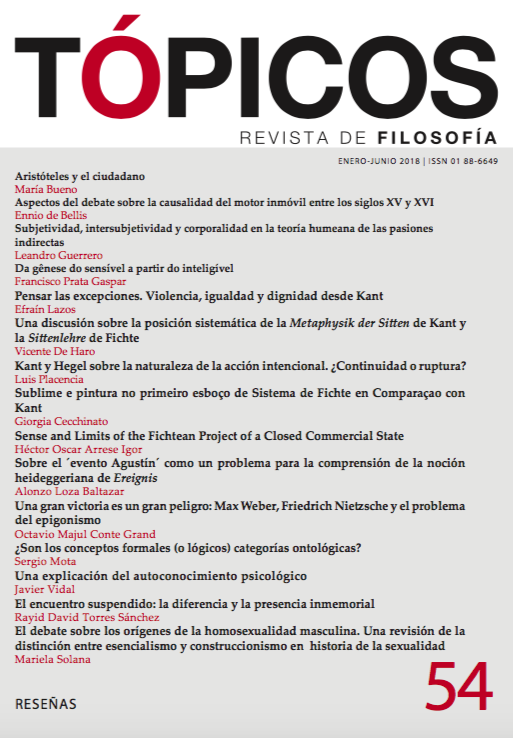Publicado 2017-11-11
Palabras clave
- inmemorial,
- negatividad,
- prolongación,
- repetición,
- presencia
Cómo citar
Resumen
Este artículo se propone tratar la relación entre lo inmemorial y la diferencia a la luz de Maurice Blanchot y Jean-Luc Nancy en términos de una pura deconstrucción de la presencia. Para ese propósito, estas páginas revisan la aproximación de ambos autores a dos episodios bíblicos (la cena de Emaús y la escena de la resurrección del evangelio de Mateo) con el fin de anudar la reflexión a la segunda parte del libro de Maurice Blanchot La comunidad inconfesable acerca de la inaprehensibilidad de la “presencia real y sencilla” y la remisión infinita de un encuentro irreductible a la despedida. A lo largo de este análisis se buscará demostrar cómo la “presencia real”, aquella que no puede estar del todo ni “ahí” ni “ahora”, pasa a ser lo inmemorial, por cuanto, no es susceptible ni de olvido ni de recuerdo, y sin embargo no nos abandona. Esto compromete no sólo la efectividad positiva y segura de lo que se muestra (aquello que se presenta para partir), sino, también, la destinación de un encuentro abocado a la disolución, y, en consecuencia, a la prolongación y la iteración.
Referencias
- Blanchot, M. (2008). La conversación infinita. Madrid: Arena Libros.
- _________ (2007). La amistad. Madrid: Trotta.
- _________ (2005). El libro por venir. Madrid: Trotta.
- _________ (2002). La comunidad inconfesable. Madrid: Editora Nacional.
- _________ (1994). El paso (no) más allá. Barcelona: Paidós.
- _________ (1992). El espacio literario. Barcelona: Paidós.
- _________ (1949). La part du Feu. Paris: Éditions Gallimard.
- Caro Valverde, M. T. (1999). La escritura del otro. (Tesis doctoral). Murcia: Ilustrada, Universidad de Murcia.
- Derrida. J. (2011). Cómo no hablar y otros textos. Denegaciones. Barcelona: Anthropos Editorial.
- _______ (1989). La escritura y la diferencia. Barcelona: Anthropos Editorial.
- Duras, M. (1984). La enfermedad de la muerte. Barcelona: Tusquets.
- Elizalde Castillo, C. (2008). Noli me Tangere. Ensayo sobre el levantamiento del cuerpo. Revista Tramas, 30, 289-293.
- Gamoneda Lanza, A. (2003). El étimo y la melancolía. Revista de Libros, 75, 11-80.
- Gamoneda Lanza, A. (1995). Marguerite Duras: La textura del deseo. Salamanca: Editorial Ilustrada, Universidad de Salamanca.
- Jay, M. (2009). Cantos de experiencia. Variaciones modernas sobre un tema universal. Buenos Aires: Paidós.
- _____ (2007). Ojos abatidos. Madrid: Ediciones Akal.
- Laporte, R. (1966). Sur Maurice Blanchot. Critique, 229.
- Lévinas, E. (2000). Sobre Maurice Blanchot. Madrid: Minima Trotta.
- Martínez González, R. (2009). Maurice Blanchot: La exigencia política. (Tesis doctoral). Zaragoza: Universidad de Zaragoza.
- Nancy, J-L. (2006). Noli me tangere. Madrid: Trotta.
- _________ (2005). Une expérience au cœur. En La Déclosion (Déconstruction du christianisme, 1). Paris: Galilée.
- _________ (2002). Un pensamiento finito. Barcelona: Anthropos.
- Quintana Domínguez, I. (2014). La exigencia de un habla plural. Literatura, pensamiento y comunidad en la obra de Maurice Blanchot. (Tesis Doctoral). Madrid: Universidad Católica de Lovaina/Universidad Complutense de Madrid.
- Rilke, R. M. (2004). Escritos como epitafio para Wera Ouckama Knoop. Madrid: Visor de poesía.
- Rodríguez Marciel, C. (2012a). Jean Luc-Nancy y Maurice Blanchot: el reparto de lo inconfesable. Revista Escritura e imagen, 8, 259-276.
- _________ (2012b). Nancytropías. Topografías de una filosofía por venir en Jean-Luc Nancy. Madrid: Dykinson.
- Rooden, A. (2011). La comunidad en obra. Jean-Luc Nancy en diálogo con Maurice Blanchot: Un desacuerdo tácito. Revista Pléyade 7. IV,1, 79-103.






